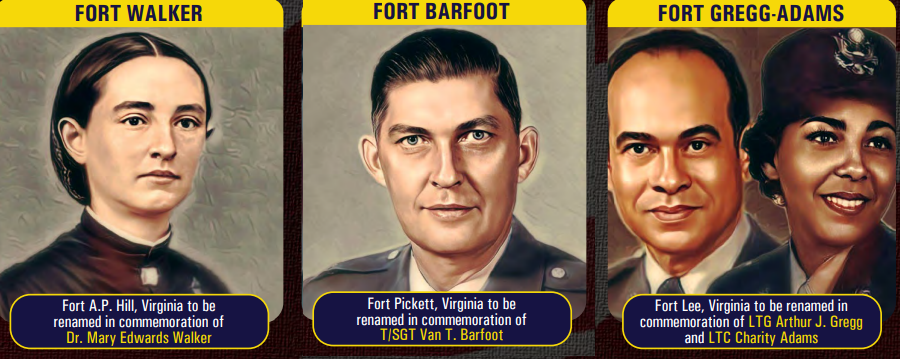 the Naming Commission identified in 2022 how to rename three US Army bases in Virginia
the Naming Commission identified in 2022 how to rename three US Army bases in VirginiaSource: Naming Commission, Department of Defense, Final Report to Congress, Part 1
 the Naming Commission identified in 2022 how to rename three US Army bases in Virginia
the Naming Commission identified in 2022 how to rename three US Army bases in Virginia
Source: Naming Commission, Department of Defense, Final Report to Congress, Part 1
In 2020, the US Congress directed the Defense Department to examine Confederacy-affiliated assets and consider renaming them. That requirement was included in the annual defense authorization bill. President Donald Trump vetoed the bill, largely over the renaming issue. At the end of December, 2020, the US Congress overrode a presidential veto for the first time since 2016.
Part 1 of the Naming Commission Final Report recommended renaming Fort A.P. Hill, Fort Lee and Fort Pickett in Virginia, and exploring if Fort Belvoir should be renamed:1
At the time, 100% of the US Army bases were named after white males. The Naming Commission recognized that did not reflect the current demographics of the U.S. population or the U.S. Army's active duty force.
The Naming Commission invited public comment on multiple alternatives for each of the three Army bases in Virginia that honored Confederate officers. Among the criteria for choosing a new name were:2
The Naming Commission recommended renaming Fort A. P. Hill to honor Dr. Mary Edwards Walker. Fort A. P. Hill had been established in 1941, at a time when the need for national unity was clear in anticipation of World War II. Federal officials deferred at the time to Virginia officials, who named the fort after a Confederate general. The Naming Commission considered 12 alternatives before choosing to commemorate Dr. Walker. Cost of the renaming was estimated at $2 million. Cost for converting Fort Lee into Fort Gregg-Adams were estimated at $2.4 million.3
Fort Pickett originally honored Confederate General George Pickett. His charge at Gettysburg in 1863 had failed, and by the end of the Civil War Robert E. Lee avoided relying upon him. Supposedly, Robert E. Lee was surprised to see Pickett in the surrender ceremony at Appomattox, and asked an aide:5
The originally estimated cost for changing all the Confederacy-related signs at nine military bases across the United States by the end of 2023 rose from $21 million to $39 million. In 2023, USA Today estimated the total cost was $60 million.6
Fort Pickett was renamed Fort Barfoot on March 24, 2023.
 the Virginia National Guard no longer trains at a facility named after a Confederate general
the Virginia National Guard no longer trains at a facility named after a Confederate general
Source: Virginia National Guard, Fort Barfoot
Camp Lee was opened in 1917, at the start of the United States involvement in World War I. The facility in Prince George County was named in honor of Confederate General Robert E. Lee, commander of the Army of Northern Virginia from 1862-65. It was closed after that war, but reopened in 1940. It has been used for quartermaster training ever since.
Camp Lee was renamed Fort Lee at the start of the Korean War, then renamed Fort Gregg-Adams in 2023. The new name honored Lt. Gen. Arthur J. Gregg and Lt. Col. Charity Adams, two black soldiers in the US Army.
Charity Adams led the 6888th Central Postal Directory Battalion. That unit unscrambled the delivery of mail to and from soldiers serving in Europe. Arthur Gregg enlisted in 1945, and became an officer after the military was desegregated in 1948. Gregg served for a time at Fort Lee, and became the first black three-star general in the US Army.7
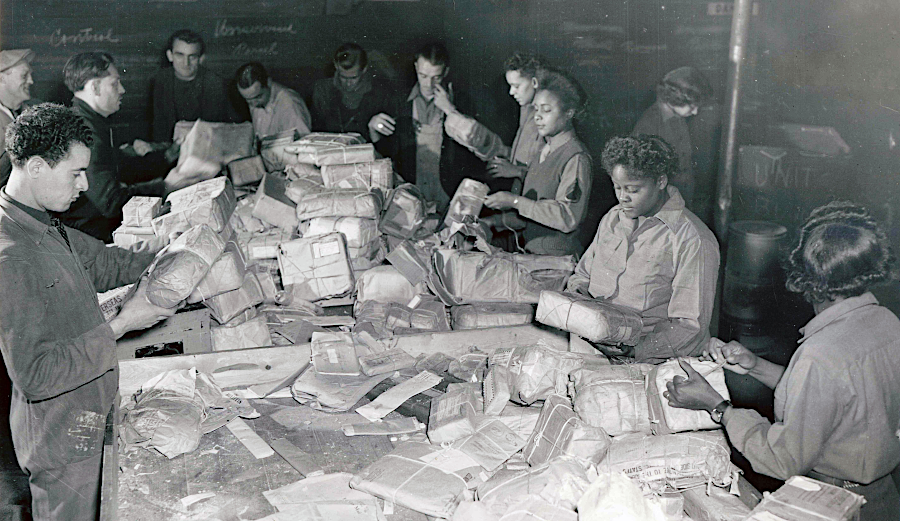 the 6888th Central Postal Directory Battalion ensured soldiers got their mail in Europe
the 6888th Central Postal Directory Battalion ensured soldiers got their mail in Europe
Source: National Archives, Photograph of the 6888th Central Postal Directory Battalion in France
Fort A.P. Hill was renamed Fort Walker on August 25, 2023. Dr. Mary Edwards Walker became the first female US Army surgeon in 1863, after her offer to serve had been rejected twice, when the Union Army needed more medical capacity during the Civil War. She was captured by Confederate troops on April 10, 1864, and initially was classified as a spy and imprisoned at Castle Thunder in Richmond before being exchanged on August 10. She was proud to have been exchanged for a person with the rank of major in the Confederate army, saying it was a "man for man" deal.
Dr. Walker was denied a military service pension after the Civil War because she had not been formally commissioned as an officer. Perhaps in consideration of that denial, President Andrew Johnson awarded her the Medal of Honor.
Her independent style and feminist beliefs were expressed clearly in her clothing choices. She wore trousers her entire adult life, even at her wedding when she married a fellow medical student, Albert Miller, in 1856. She chose not to say "to obey" in the marriage ceremony, and afterwards retained her own name.
 Fort A.P. Hill was renamed Fort Walker on August 25, 2023
Fort A.P. Hill was renamed Fort Walker on August 25, 2023
Source: US Department of Defense, Fort Walker is the only Army installation named solely for a female (as of March 14, 2025)
In 1917, her Medal of Honor was revoked as the military reassessed eligibility. Many awards were revoked at that time, as the prestige of the Medal of Honor was raised. Dr. Walker did not qualify because she was a civilian who had been designated only as "acting assistant surgeon" after being exchanged in 1864.
She refused to return the medal and continued to wear it until she died two years later. President Jimmy Carter reinstated her Medal of Honor award in 1977, and Dr. Walker remains the only female to have earned it.8
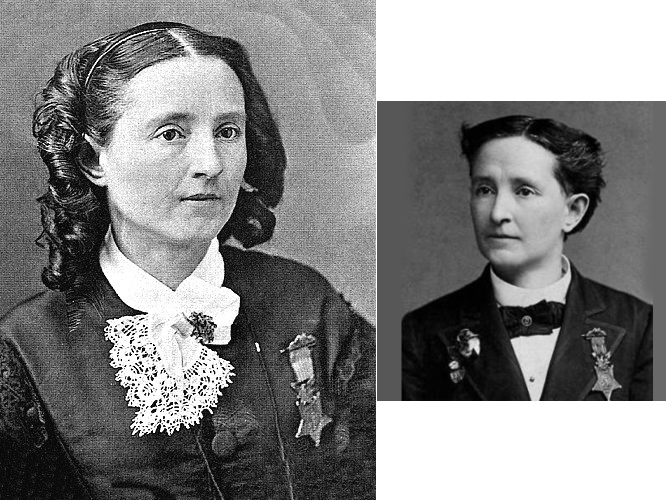 Dr. Walker was the first - and so far only - female recipient of the Medal of Honor
Dr. Walker was the first - and so far only - female recipient of the Medal of Honor
Source: Holloman Air Force Base, Mary Edwards Walker - a woman ahead of her time and National Women's History Museum, Mary Edwards Walker
When President Trump started serving his second term in 2025, he rolled back diversity, equity and inclusion initiatives. His Secretary of Defense, Pete Hegseth, renamed Fort Liberty in North Carolina as Fort Bragg. The fort was called Camp Bragg in 1918, named Fort Bragg in 1922, and renamed Fort Liberty in 2023. The 82nd Airborne Division and the U.S. Army Special Operations Command are based there; as they are deployed, the fort is often in the news.
The "Bragg" in 2025 was an Army private, Roland L. Bragg, who had received the Silver Star in World War I - not Confederate General Braxton Bragg for whom the fort had originally been named. The legislation that created the Naming Commission authorized the Secretary to name military facilities, so long as the name was not associated with the Confederacy or segregationist activity.9
The Trump Administration's rollback of all Diversity, Equity and Inclusion (DEI) references included removal of web pages about renaming Fort Pickett after T/SGT Van T. Barfoot. The "Home of US Army Sustainment is now Fort Gregg-Adams" page was deleted.
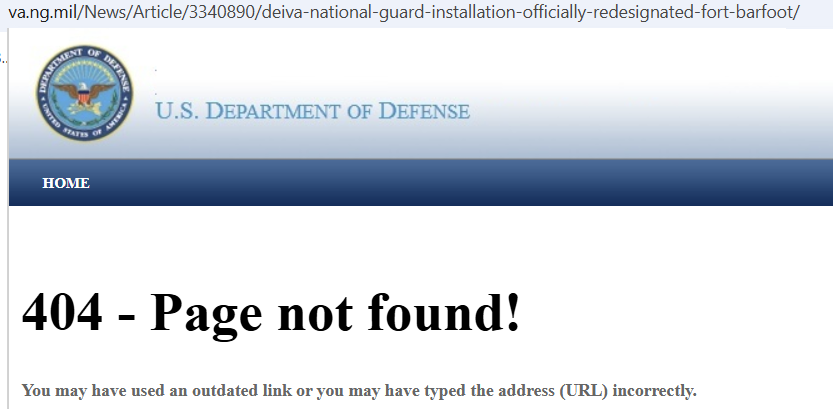
 online material regarding the renaming of Fort Barfoot/Fort Pickett and Fort Gregg-Adams/Fort Lee was removed by the Department of Defense in March 2025
online material regarding the renaming of Fort Barfoot/Fort Pickett and Fort Gregg-Adams/Fort Lee was removed by the Department of Defense in March 2025
Source: US Department of Defense, 404 - Page Not Found!, 404 - Page Not Found! (as of March 14, 2025)
The military removed material about the Leigh Street Armory in Richmond as well. That armory was built in 1895 for the First Battalion Virginia Volunteers, a militia company consisting of black men. The militia company was disbanded in 1899. The structure later served as a school for black children when the Virginia educational system was segregated, and is now home of the Black History Museum and Cultural Center of Virginia.
The nomination form to the National Register of Historic Places includes:10
The webpage describing the unique status of Fort Walker (formerly Fort A. P. Hill), being named after a female, survived the initial purge. A new name was announced for that military installation several months later.
 the initial purge of Diversity, Equity and Inclusion (DEI) references did not delete the page hifghlighting that Fort Walker was named after a female soldier
the initial purge of Diversity, Equity and Inclusion (DEI) references did not delete the page hifghlighting that Fort Walker was named after a female soldier
Source: US Department of Defense, Fort Walker is the only Army installation named solely for a female (as of June 19, 2025)
President Trump announced in June, 2025 that he would restore the names of all US military bases once named for Confederates. He claimed the new names would honor people not associated with the Confederacy, but just happened to have the same names. That sophistry was required to avoid conflict with the law passed by the US Congress that banned the use of Confederate names.
Defense Secretary Pete Hegseth, when asked by Virginia Senator Tim Kaine to pull the orders to revert to names that were parallel to those of Confederate generals, said in Congressional testimony that:11
Fort Barfoot was to be renamed after First Lieutenant Vernon W. Pickett, who won the Distinguished Service Cross in World War II. He was captured in France in 1944, but escaped from the prisoner of war train. He died in action two weeks after rejoining his unit in France.

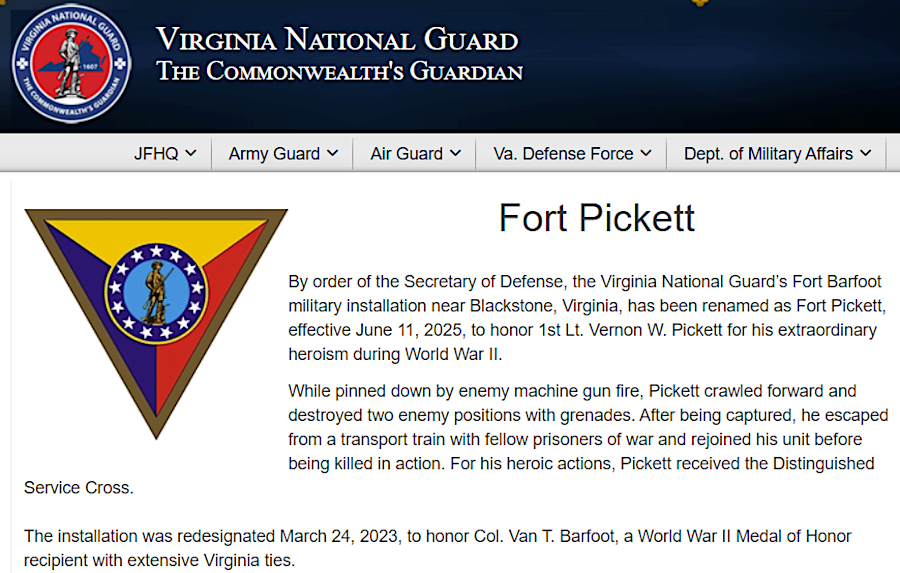 Fort Barfoot quickly revised its website and address to acknowledge the name change back to Fort Pickett in 2025
Fort Barfoot quickly revised its website and address to acknowledge the name change back to Fort Pickett in 2025
Source: Virginia National Guard, Fort Barfoot, Fort Pickett
Finding equivalent names for some facilities was a challenge. The US Army said it would revise the name of Fort Walker, once called Fort A. P. Hill in honor of a Confederate General, to Fort Anderson-Pinn-Hill. The last names of three Union soldiers who served in the Civil War, Lieutenant Colonel Edward Hill, First Seargent Robert A. Pinn and Private Bruce Anderson, were combined to create the closest equivalent the Trump Administration could find to the fort's original name.
All three won the Medal of Honor. Anderson and Pinn were black soldiers, Pinn and Hill fought in Virginia during the Civil War, and Hill is buried in Fredericksburg.


 banner of Fort A.P. Hill/Fort Walker website changed with the name of the facility (August 19, 2023, June 13, 2025, June 19, 2025)
banner of Fort A.P. Hill/Fort Walker website changed with the name of the facility (August 19, 2023, June 13, 2025, June 19, 2025)
Source: US Army, Fort A.P. Hill; Fort Walker
There was confusion regarding replacing Fort Gregg-Adams with Fort Lee again. President Trump said the facility would be renamed "Fort Robert E. Lee." However, the US Army said it would be renamed after Private Fitz Lee, a Buffalo Soldier who won the Medal of Honor in the Spanish-American War. The statue to Charity Adams, erected in 2018, still stands at Fort Lee.12

 Fort Gregg-Adams was renamed in 2025 to Fort Lee again, but technically not after Robert E. Lee
Fort Gregg-Adams was renamed in 2025 to Fort Lee again, but technically not after Robert E. Lee
Source: US Army, US Army Garrison Fort Gregg-Adams
Stanley Earley III, the son of Charirty Adams (who also used the name Charity Adams-Earley), said:13
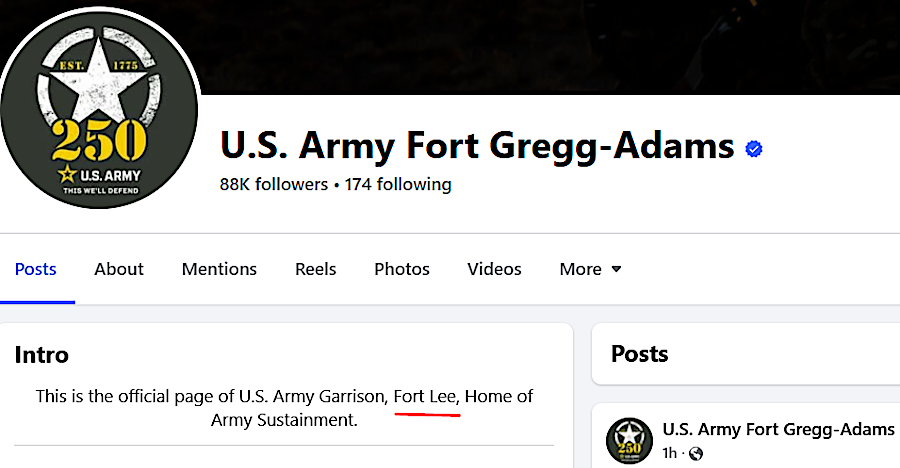 updating the social media sites of military bases renamed in 2025 occurred in stages
updating the social media sites of military bases renamed in 2025 occurred in stages
Source: Facebook, U.S. Army Fort Gregg-Adams (June 19, 2025)
 Fort Lee was renamed in 2025 after Private Fitz Lee, a Buffalo Soldier who won the Medal of Honor in the Spanish-American War
Fort Lee was renamed in 2025 after Private Fitz Lee, a Buffalo Soldier who won the Medal of Honor in the Spanish-American War
Source: Smithsonian National Museum of African American History and Culture, Photograph of Fitz Lee
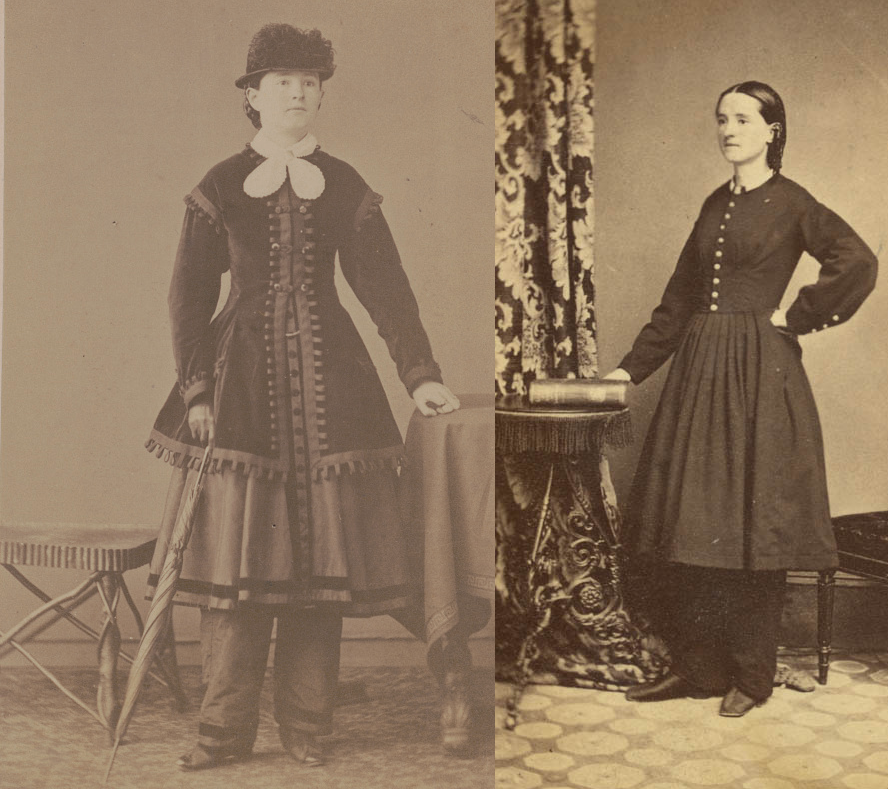 Dr. Walker wore trousers throughout her life, defying fashion in exchange for comfort
Dr. Walker wore trousers throughout her life, defying fashion in exchange for comfort
Source: Library of Congress, Dr. Mary Edwards Walker and Mary E. Walker